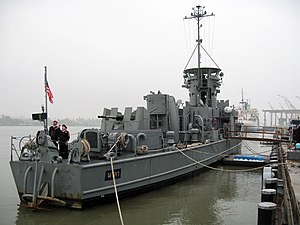Landing Craft Support

Ex-LCS(L)-102 (HTMS Nakha)
|
|
| Class overview | |
|---|---|
| Builders: | George Lawley & Son, Commercial Iron Works and Albina Engine Works |
| Preceded by: | LCI(G) |
| In commission: | 1944 |
| Completed: | 130 |
| Active: | 0 |
| Retired: | 130 |
| Preserved: | 1? |
| General characteristics | |
| Displacement: | 250 long tons (250 t) |
| Length: | 158 ft 6 in (48.31 m) |
| Beam: | 23 ft 3 in (7.09 m) |
| Draft: | 5 ft 10 in (1.78 m) (aft, loaded) |
| Propulsion: |
|
| Speed: | 16.5 knots (30.6 km/h) |
| Range: | 5,500 nmi (10,200 km) |
| Complement: | 3–6 officers, 55–68 men |
| Armament: |
|
| Armor: | 10-lb. STS splinter shields |
The Landing Craft, Support (Large) — later reclassified Landing Ship Support, Large — class of amphibious warfare ships were used by the United States Navy in World War II in the Pacific. They were primarily used for close support before landing forces on beaches. They also performed radar picket duty and fire fighting. They were nicknamed the "Mighty Midgets".
The original designation for the ships was LCS(L)(3), which stood for "Landing Craft Support (Large) Mark 3". In 1949 the class was reclassified to "Landing Ship Support, Large" (LSSL). The USN had to have the designation LCS(L) because there was also a smaller class named LCL, that were built mainly for rescue and smoke laying during amphibious operation.
A total of 130 were made. Three different ship building yards did the construction: George Lawley & Son (Neponset, Massachusetts); Commercial Iron Works (Portland, Oregon); and Albina Engine Works (Portland, Oregon).
The hull was the same as the Landing Craft Infantry ships. They were 158 ft 6 in (48.31 m) long, displaced 250 long tons (250 t), 23 ft 3 in (7.09 m) wide and drew 5 ft 10 in (1.78 m) when fully loaded. The flat bottom and skegs between and on either side of the twin screws allowed the ships to safely beach. The anchor is at the stern of the ship so it can be used to help pull the ship off the beach if necessary.
The twin variable pitch screws were each driven by a bank of four Grey Marine (later General Motors) diesel engines, with a total power for all eight engines of 1,600 horsepower (1,200 kW). These engines gave a maximum speed of 16.5 knots (30.6 km/h), but normally the ships sailed at 12 knots (22 km/h). The ships had a range of 5,500 nautical miles (10,200 km).
...
Wikipedia
